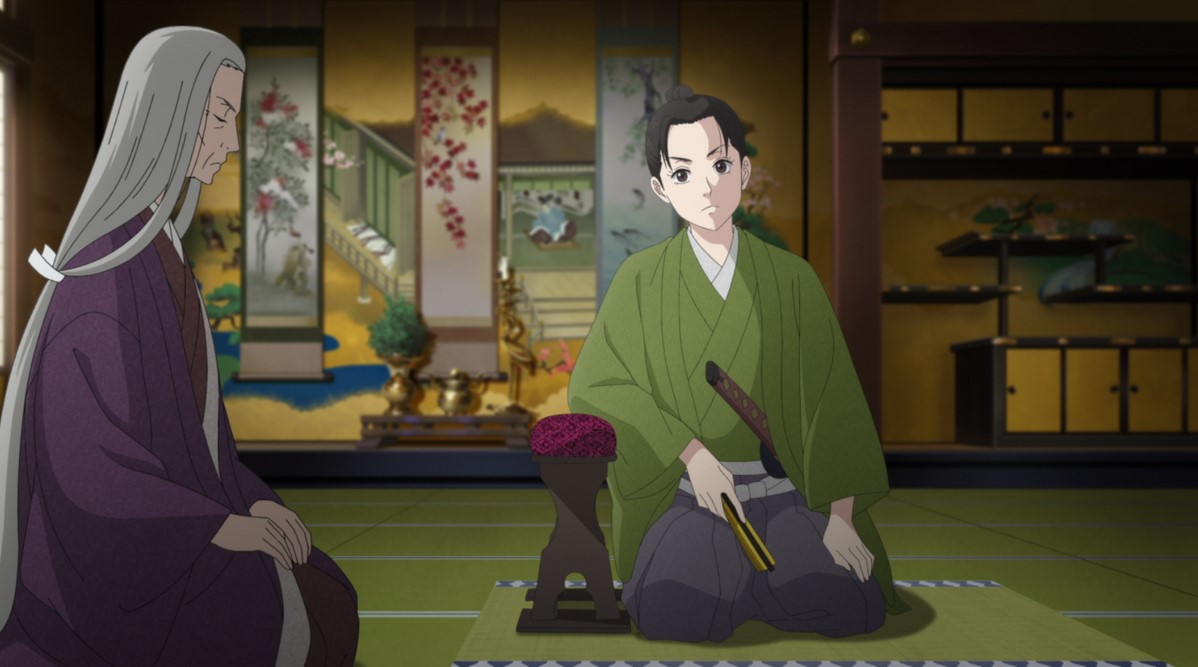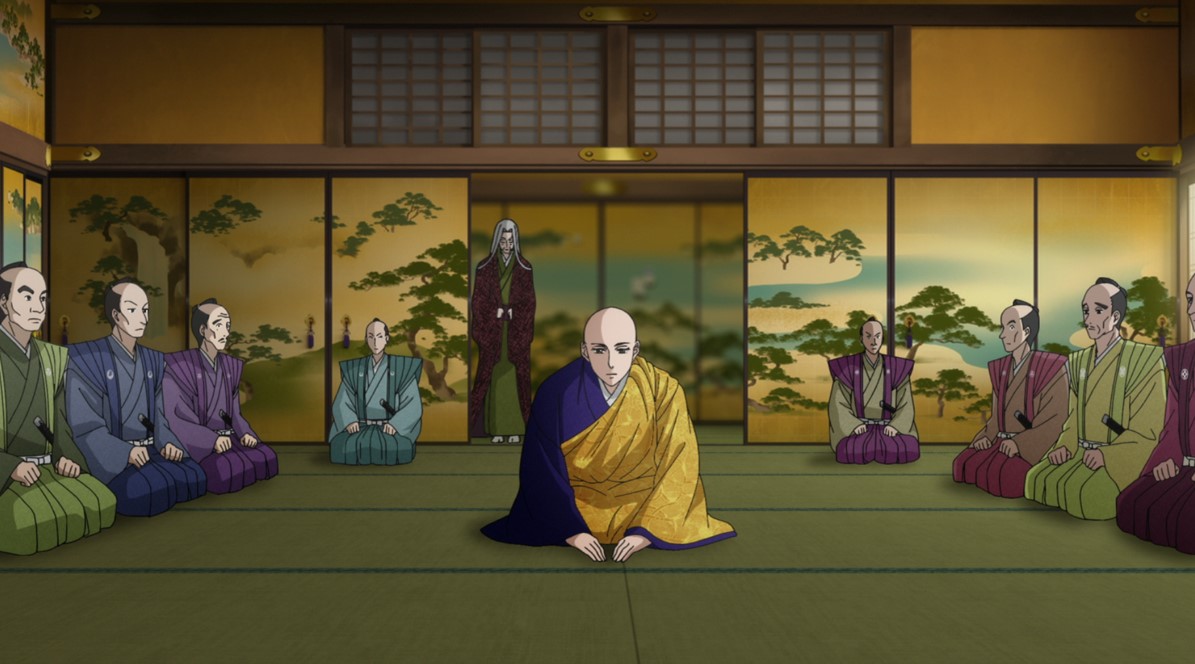Based on the Japanese manga series written and illustrated by Fumi Yoshinaga, Netflix’s ‘Ōoku: The Inner Chambers’ is set in an alternate version of the Edo period Japan where the male population has dwindled down to one-fourth that of women due to a devastating plague known as the red-face smallpox, leading to women becoming the labor force of every aspect of daily society and all trades and occupations, including the shogunate, passed from mother to daughter. The institution of marriage has come virtually undone. Only women of extremely privileged status can afford marriage, while others visit the pleasure districts, which now exclusively house men if they seek pleasure or want to have children. Families sell their male children for wealth and influence. The women from poorer backgrounds can only hope that one of the remaining men in their area will be kind enough to sleep with them.
In ‘Ōoku: The Inner Chambers,’ many characters who are males in history are depicted as women, and vice versa. The story begins in the 18th century as Yoshimune, the eighth Shogun of the Tokugawa shogunate, wonders why women take male names when they inherit properties from their mothers. This complicates the attempts to keep accurate statistics for the country, and that, in turn, prevents the administration from functioning smoothly. The answer she finds is in a book called ‘The Chronicles of the Dying Day,’ which records what happened at the Edo Castle, especially in the Ōoku, or the inner chambers, when the disease first began to spread during the reign of the third Shogun, Iemitsu. Here is everything you need to know about the ending of ‘Ōoku: The Inner Chambers.’ SPOILERS AHEAD.
Ōoku: The Inner Chambers Recap
By the time of Yoshimune, Ōoku, which was historically the women’s quarters, houses about 800 men. Yoshimune seeks to usher in sweeping reforms across the country to remedy the tremendous financial hardships the shogunate faces, and Ōoku is no exception. She dismisses scores of young men from service, so other women can marry them, preferring to be with men in their late 30s, 40s, or older. One of the things that bother her the most is the tradition for women to take up male names when they inherit their mother’s properties, causing a big administrative problem.
As at least eight decades have passed since the reign of Iemitsu, people, including the ruling class, seem to have forgotten how things used to be before the outbreak. She goes to speak to the Chief Scribe Murase Masasuke, the man in charge of writing documents and missives addressed to the Outer Chambers and beyond and recording everyday events at the Ōoku. He is 97 years old, so he had seen the country before it was ravaged by the outbreak. At present, the head of Ōoku or Senior Chamberlin is a man named Fujinami. But Murase reveals to Yoshimune that there was a time women occupied that position. In fact, the legendary politician Kasuga, who effectively saved the Tokugawa shogunate, was a woman. He also reveals that Iemitsu was initially a man. As Yoshimune reads ‘The Chronicles of the Dying Day,’ she begins to realize why some of the rules causing problems for her administration were originally implemented.

The story begins in the 17th century, as does the outbreak, though some aspects of the narrative, especially the childhood of Kasuga, can be traced back to the 16th century. During the reign of Tokugawa Iemitsu, a boy from a rural mountain village in the Kantō region goes out to the forest to pick the season’s first mushroom for his mother, and a bear attacks him. Although his family found him, he soon dies. Not long after, all the male members of his family perish because of a mysterious disease in which red pustules cover a victim’s body. The disease begins to spread rapidly through the Kantō region before venturing westward. It primarily targets male children and young men, but in rare cases, older men also contract the disease.
The main narrative revolves around a handsome monk named Arikoto, Kasuga, and Chie, the daughter of the original Iemitsu, who was a man. He raped Chie’s mother, and as he dies of the red-face smallpox before he can produce a male heir, a desperate Kasuga brings Chie to Edo Castle to pose as her father and produce the future male heir of the Tokugawa shogunate. She forces Arikoto to leave his life as a monk to come live at Ōoku and become Chie’s male concubine. Arikoto and Chie (who is known as Iemitsu by then) grow close despite all the odds and fall in love.
However, their sexual encounters do not produce an heir, prompting Kasuga to bring in other men, the first of whom is a son of a merchant, Sute. Despite her reluctance, Iemitsu performs her duty and eventually gives birth to a daughter, whom she names Chiyo. She goes on to have two other children, including one with Gyokuei, Arikoto’s younger companion who has been with him since his monk days.
Ōoku: The Inner Chambers Ending: Why Do Women Take a Male Name while Succeeding as the Head of the Family?
Although the main narrative revolves around what transpires at Ōoku, there are various subplots depicting how the rest of the country deals with the radical changes that the plague brings to the society, every section of which gradually becomes matriarchal. The peasants and similar classes of people are the first to respond to the drastic change in their world, and nobility is the last. Most governors who directly serve under the Shogun don’t contract the disease, but their male children do and die. It becomes increasingly apparent that they have no other choice but to name their daughters as their heirs. They initially do it secretly, but they soon discover that their colleagues are doing it as well, leaving them with no reason to hide it.

With the critical depletion of young men, there are no wars, so the samurai don’t need to perform their primary duty. Outside threats are still a reality as the plague has only affected Japan. As a result, even though the Shogun begins to appear as herself in front of her people, she ensures that the foreign influence on the country will be at a minimum, strengthening Japan’s isolation policies.
As she reveals herself as a woman, Chie asserts this is a temporary measure. Her role is to occupy the seat until a male heir is born in the Tokugawa line. As such, she will continue to use the name and title of her father. The daughters of noble families do the same. However, the male population doesn’t rise in 80 years, remaining at a stable one-fourth of the female population.
What is a Secret Swain? How Did It Start?
The Secret Swain is the title bestowed upon the first concubine who sleeps with an unmarried Shogun. As his duties involve introducing the presumed virgin Shogun to the intricacies of the bed chamber, it is believed that he is committing a great crime by taking her virginity. As a result, he is secretly executed.

In the season finale, we learn that Chie/ Iemitsu started Secret Swain because she was raped not long after she was brought to Edo Castle. She killed the man and later discovered she was pregnant with his child. Although she gave birth, the child died soon after. This series of incidents left her traumatized, and while establishing rules for the Ōoku, she seeks to punish every man who sleeps with a virgin Shogun in the future. Arikoto, who has been severely changed by his experience at the Edo Castle, doesn’t offer much protest when she makes Secret Swain into law. However, Yoshimune spares the life of Mizuno, the man who was slated to become her Secret Swain.
Do Arikoto and Iemitsu (Chie) End up Together?
No, Arikoto and Iemitsu do not end up together. In the season finale, Arikoto begs Iemitsu to relieve him from his duties in the bed chamber, stating that it has become too much for him to see her with other men and have their children. Although it breaks her heart, she grants him his wish and makes him the first Senior Chamberlin. Iemitsu, or the first female Shogun, dies at 27 after suffering several miscarriages.

Some of her concubines, including Gyokuei, become monks, while others commit ritualistic suicide, unable to remain in the world after the death of their beloved Shogun. Kasuga was already dead at this point. Murase is her son. She appointed him Chief Scribe at her deathbed, instructing him to continue to take notes as he had done for years. She feared that the plague would cause the destruction of the country and told him to chronicle the events until the very end. As for Arikoto, he doesn’t return to his monkhood, choosing to stay at the Edo Castle and raising the fourth Shogun, just as Iemitsu asked him to on her deathbed.
Read More: Best Romantic Anime on Netflix


You must be logged in to post a comment.